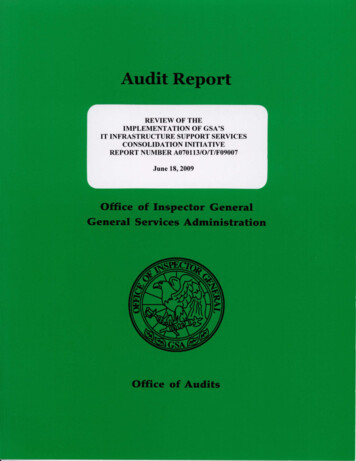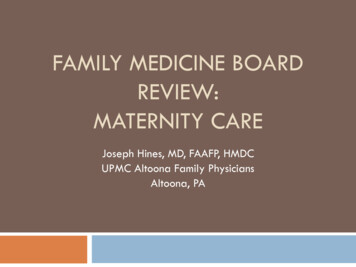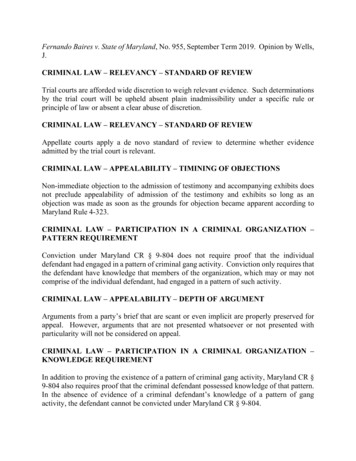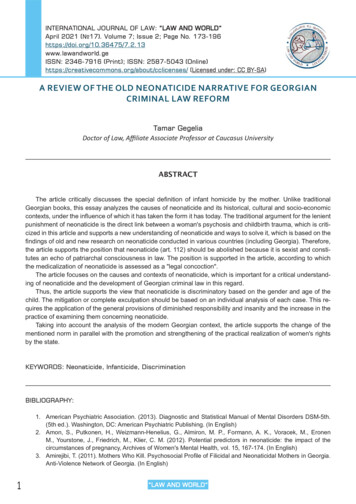
Transcription
REVIEW OF THEIMPLEMENTATION OF GSA’SIT INFRASTRUCTURE SUPPORT SERVICESCONSOLIDATION INITIATIVEREPORT NUMBER A070113/O/T/F09007June 18, 2009
u.s. GENERAL SERVICES ADMINISTRATIONOffice of Inspector GeneralDate:June 18,2009Reply toAttn of:Gwendolyn A. McGowanDeputy Assistant Inspector General for Infonnation Technology Audits(JA-T)To:Casey ColemanChief Information Officer (I)Subject:Review of the Implementation of GSA's IT Infrastructure Support ServicesConsolidation InitiativeReport Number A070 l13/0/T/F09007This report presents a summary of the results of our audit of the General ServicesAdministration's (GSA) Infrastructure Technology Global Operations (GITGO) consolidationinitiative. The report highlights our audit findings and recommendations to the Agency's Officeof the Chief Information Officer (OCIO) for improving the security, service, and cost validationof the consolidated infrastructure support services. With the GITGO initiative, the GSA OCIO ismoving the Agency toward a standard, enterprise-wide resource management framework toestablish and sustain effective and efficient infonnation technology (IT) infrastructure supportservices. Accordingly, our review focused on risk areas where additional management attentionmay be needed to ensure that lessons learned with GITGO are adequately addressed to supportGSA's infonnation technology project management goals. We coordinated closely throughoutthe audit with program officials responsible for the GITGO implementation and carefullyconsidered controls for managing security, service, and costs associated with the infrastructuresupport services.On March 30, 2009, we provided our preliminary findings andrecommendations in a presentation to you and your staff. We have incorporated infonnation thatyou provided and a copy of our updated briefing slides is contained in Appendix A. Due to thesensitive nature of the detailed findings in the appendix, we are restricting distribution of thatinfonnation to your office.BackgroundThe GITGO perfonnance-based task order was awarded to Catapult Technology, Ltd. onFebruary 28, 2007 for the purpose of consolidating GSA's IT infrastructure support services.With GITGO, 40 existing contracts with approximately 59 million in annual infrastructuresupport costs were consolidated into a single contract valued at approximately 40 millionannually. Program management, IT Service Desk/Help Desk, and local support services sub tasks are firm fixed-priced, and client management services and network operations sub-tasks arelabor-hour contract line items. The GITGO initiative is part of GSA's Exhibit 300 capital assetplan and business case for enterprise infrastructure. The Exhibit 300 is required to coordinateOffice of Management and Budget's (OMB) collection of agency infonnation to ensure the241 18th Street 5., CS4, Suite 607, Arlington, VA 22202-3402Federal Recycling Program-0Printed on Recycled Paper
business case for investments are made and tied to the Agency’s mission statements, long-termgoals and objectives, and annual performance plans. GSA’s phased implementation of GITGOservices started with the contract award 12-month base period and continues with four 12-monthoption periods to consolidate the IT infrastructure support services. Expected benefits from theGITGO initiative to consolidate GSA’s internal contracts for desktop computing, networking,messaging and other services were: (1) combining 40 disparate contracts into one consolidatedcontract; (2) enhancing efficiency by aligning functions performed by multiple organizations andlocations; (3) establishing consistent IT infrastructure levels of service throughout GSA; (4)establishing a consolidated help desk for all IT infrastructure issues; (5) improving managementcontrols over funding for IT infrastructure, as funding will be consistently documented andanalyzed; and (6) simplifying enterprise efforts such as implementing new software versions,responding to various security issues, and maintaining asset inventories.Objective, Scope, and MethodologyOur audit objective was to assess whether risks with GSA’s consolidation of IT support serviceshave been adequately mitigated by determining if: (1) the GSA Infrastructure TechnologyGlobal Operations (GITGO) initiative for IT infrastructure support consolidation is generatingexpected cost savings and other benefits; (2) GSA’s consolidated IT Service Desk is operatingeffectively, efficiently, and securely; and (3) GSA and the GITGO contractor are developing andimplementing Information Technology Infrastructure Library (ITIL) processes to align ITsupport services to customer needs. If not, what changes are needed to ensure successfulimplementation of the GITGO initiative?We gathered and analyzed information related to security, IT Service Desk operations, andinfrastructure support services costs, which included the GITGO performance work statement(PWS), deployment of the ITIL framework, funding and justifications, strategic goals andobjectives, standard operating procedures, performance measures, and service level agreements(SLA).We met with GITGO officials and customers from the Federal Acquisition Service (FAS), PublicBuildings Service, and Office of Governmentwide Policy. We also met with GITGO contractorpersonnel and FAS officials responsible for the Information Technology Infrastructure Line ofBusiness. We visited the GITGO IT Service Desk in Chambersburg, PA for an overview ofoperations. For our IT security assessment, we relied on commercial tools and agreed-uponprocedures in place with the GSA Chief Information Officer (CIO) to evaluate operations at theUnicenter Service Desk in St. Louis, MO. In January 2009, we also reviewed a limited sampleof service desk tickets that included active tickets, tickets referred by FAS personnel, and ticketsassociated with malicious code.We considered applicable statutes, regulations, policies, operating procedures, and industry bestpractices regarding the development and implementation of the GITGO infrastructureconsolidation such as: the PWS for the General Services Administration Office of the ChiefInformation Officer (OCIO) GSA Infrastructure Technology Global Operations, awardedFebruary 2007, Task Identification Number A06S47T0040; GSA Information Technology (IT)Security Policy, CIO P 2100.1D, June 2007; National Institute of Standards and Technology2
(NIST) Special Publication (SP) 800-61, Revision 1, Computer Security Incident HandlingGuide, March 2008; GSA Information Technology (IT) Capital Planning and InvestmentControl, CIO 2135.2A, September 2006; GSA Information Technology (IT) Capital Planningand Investment Control, CIO 2135.2B, November 2008; GSA Information Technology (IT)Governance, CIO 2130.1, November 2008; Gartner Toolkit: IT Service Desks Must Understandthe Importance of First Contact Resolution, June 2007; OMB M-05-23 – Improving InformationTechnology (IT) Project Planning and Execution, August 2005; OMB M-05-04 – Policies forFederal Agency Public Websites, December 2004; ITIL Service Support Version 2.6, 2000; ITILService Delivery Version 2.4, 2001; GSA IT Strategic Plan 2009 - 2011, August 2007; TheClinger Cohen Act of 1996; and OMB A-94 – Guidelines and Discount Rates for Benefit-CostAnalysis of Federal Programs, October 1992.This audit work began in February 2007 and was completed by February 2009. We conductedour audit work in accordance with generally accepted government auditing standards. Thosestandards require that we plan and perform the audit to obtain sufficient, appropriate evidence toprovide a reasonable basis for our findings and conclusions based on our audit objective. Webelieve that the evidence obtained provides a reasonable basis for our findings and conclusionsbased on our audit objectives.Results in BriefThe expected benefits for implementing GITGO include the establishment of consistent ITinfrastructure levels of service throughout GSA, a consolidated service desk/helpdesk for all ITinfrastructure issues, and improvement of management controls for funding IT infrastructure.Our review identified findings related to security, service, and cost validation risks that couldhinder long-term success for GITGO if not adequately addressed. We have identified securitycontrols that need to be strengthened in the areas of web application, database, and operatingsystem platform security in response to results of technical scanning and other testing.Specifically, important risk management activities for the Unicenter Service Desk infrastructure,including certification and accreditation, the assignment of an Information System SecurityOfficer (ISSO), and completion of an IT contingency plan should be prioritized. We also foundthat comprehensive procedures are not yet in place for service desk handling of securityincidents, and audit trails for the remote support solution used by the IT Service Desk are notbeing analyzed for suspicious activity. An official GSA governance body should be utilized toreview and approve changes to service level agreements as needed to monitor the performance ofthe infrastructure support processes. The IT Infrastructure Library (ITIL) is the selected ITservice management framework for GITGO. However, a GITGO-specific ITIL plan, withmilestones, is needed for guiding the development and implementation of ITIL disciplines forimproving GSA’s IT infrastructure services. Enhanced procedures are needed for theconsolidated IT Service Desk to improve day-to-day operations. Since procedures were notadequate for verifying the pre-consolidation cost baseline information, the OCIO should improvethe cost validation process to ensure the accuracy of future cost baselines for monitoringinfrastructure support services. Taking steps to ensure improvements with GITGO at this timewill assist GSA in progressing toward more standardized processes, reliable infrastructuresupport services, and efficiencies in GSA operations. To address the identified risk areas, we3
have made specific recommendations for improving security, service, and cost validation for theGITGO initiative.Summary of Audit FindingsCompletion of Important Risk Management Activities Could Provide Assurance of RequiredSecurity ControlsSome technical control testing has been performed by system security officials at the UnicenterService Desk (USD); however, the USD infrastructure 1 is operating without assurance of keyrisk management activities such as the completion of a certification and accreditation (C&A) ofsystem security controls, the assignment of an Information System Security Officer, and thedevelopment of an IT contingency plan. Steps taken with GITGO to manage key C&A activitiesfor the USD infrastructure have not been sufficient to manage specific risks. GSA’s IT SecurityPolicy establishes requirements for system authorization, system roles and responsibilities, andIT contingency planning. Without the completion of these key risk management activities,system security officials may not be able to determine the extent to which the controls areimplemented correctly, operating as intended, and producing the desired outcome with respect tomeeting the security requirements for the USD infrastructure.Vulnerabilities Identified Could Be Mitigated Through More Secure Configurations for Portionsof the IT Service Desk InfrastructureOur tests found specific instances of vulnerabilities that could be mitigated through more secureconfigurations for the USD infrastructure. GSA’s IT Security Policy establishes detailedrequirements for ensuring adequate protection of GSA IT resources. However, hardeningpractices for the IT Service Desk were not adequate to comprehensively address risks in webapplications, databases, and operating systems. Additionally, key IT security requirements werenot addressed in the performance measures included in the Performance Work Statement. Thesevulnerabilities could expose the USD infrastructure to undue risks affecting the confidentiality,integrity, or availability of the IT Service Desk. The details of these vulnerabilities are securitysensitive and have been provided in Appendix A.Additional Guidance Could Better Equip the IT Service Desk with IT Security Incident HandlingResponsibilitiesWe identified weaknesses with security incident handling for the IT Service Desk in the areas ofincident reporting and incident mitigation. These weaknesses had two contributing causes. First,comprehensive procedures are not yet in place to guide service desk handling of securityincidents. Second, GITGO security officials determined that service desk personnel were notassigned significant security responsibilities and, therefore, were not required to complete rolebased training provided under GSA’s IT Security Program. While all service desk personnelmust complete GSA’s IT Security Awareness training to maintain their GSA email accounts, thisbasic training does not address all security incident handling responsibilities for service deskpersonnel. The GSA-CIO has issued a procedural guide that documents the required incidenthandling process for all users of GSA IT resources, including contractor personnel who have1For the purpose of this report, the USD infrastructure refers to the servers and applications supporting the ITService Desk in St. Louis, MO.4
access to GSA resources, or otherwise provide services to GSA that handle or process GSA data.Without a comprehensive incident handling capability, GSA may not be able to effectivelymitigate the exploited weaknesses. The details of these weaknesses are sensitive in nature andare included in Appendix A.Monitoring Audit Trails for the Remote Access Solution Could Assist in Detecting and DeterringPotential Unauthorized ActivityAudit trails for the remote support solution used by the IT Service Desk personnel were notanalyzed for suspicious activity. GSA’s IT Security Policy states that audit records must bereviewed frequently for signs of unauthorized activity and other security events. This is animportant security control since audit trails are used to deter and detect unauthorized access tocomputer systems and to help reveal potential misuse. However, system officials stated that theywere uncertain regarding which activities should be analyzed in the available audit trails. By notanalyzing audit trails, unauthorized activity or other potential security breaches may not beavoided or detected.Senior Management Review and Approval Could Improve Service Level AgreementsUnder GITGO, service level agreements (SLA) are used for incentivizing certain metrics,including the performance of the IT Service Desk. SLAs document the boundaries and servicelevel goals of the agreed-upon services that will be provided to a specific customer, and setsforth specific penalties if the service provider fails to provide the agreed-upon services or to meetthe agreed-upon goals. The SLAs for GITGO were revised to modify the definition of FirstContact Resolution to count tickets that have been dispatched correctly as resolved. Accordingto Gartner 2 , First Contact Resolution is “the most fundamental of all metrics.” While a GSAgovernance body had a charter to review SLAs, the revised SLAs were negotiated but notformally approved. Further, the Information Technology Infrastructure Library (ITIL)recommends the following for service level agreements: “Generally speaking, the more seniorthe signatories are within their respective organizations, the stronger the message ofcommitment.” Without senior management approval, SLAs may not be incentivizing the mosteffective metrics for GITGO operations. Senior management, including stakeholders fromGSA’s Services, Staff Offices, and Regions may not be held accountable for the selection ofmetrics for IT service support needs under GITGO.Establishment of Milestones and Implementation Plan Needed to Realize Benefits from SelectedIT Service Management ProcessesThe GITGO Performance Work Statement (PWS) states that GSA will adopt the following ITILprocesses at a minimum: (1) Problem Management, (2) Incident Management, (3) ChangeManagement, (4) Release Management and (5) Configuration Management. We discussed theseprocesses with the OCIO and documentation was provided on the status of ITIL for GITGO.However, this documentation does not include milestones to develop and guide theimplementation of selected ITIL processes. Our analysis identified that the reason milestoneshave not yet been developed was that the PWS did not include milestones for oversight for thephased implementation of ITIL. New major IT projects in the Federal government are requiredto establish baselines with clear schedule and performance goals. Without a detailed2Gartner Toolkit: IT Service Desks Must Understand the Importance of First Contact Resolution, June 2007.5
implementation plan that considers such project management requirements, GSA may not beable to adequately address risks for GITGO ITIL implementation or meet important goals forstandardized processes and reliable infrastructure, as outlined in the GSA IT Strategic Plan.More Consistent Response to Tickets Could Be Achieved Through Standard Procedures to Guidethe IT Service Desk OperationsTrouble tickets are used by IT organizations to track the detection, reporting, and resolution ofproblems reported by its customers. The GITGO IT Service Desk receives an average of 18,300trouble tickets per month. We reviewed a sample of 75 tickets that included: 46 active tickets, 4tickets referred by Federal Acquisition Service personnel, and 25 tickets associated withmalicious code. Our analysis identified inconsistencies in IT Service Desk ticket handling,which may lead to inefficiencies. Specifically, service desk personnel did not consistentlyidentify related tickets, set ticket categories, or classify tickets as an issue or change order.Further, we identified tickets that were not resolved in a timely manner. These inconsistencieswere due to incorrect routing of tickets or procedures that were not comprehensive. Aperformance objective stated in the PWS for the IT Service Desk is to deploy a consolidated,enterprise help desk resulting in a reliable delivery of service. In addition, the PWS states that agoal for the GITGO initiative is to develop and deploy agency approved standard processes.Inconsistent handling of incidents by the IT Service Desk could lead to difficulty in analyzingthe effectiveness of IT Service Desk operations and may impact ability of the IT Service Desk toconsistently resolve trouble tickets in a timely manner.Enhancing the Process for Verifying Cost Baselines Associated with Infrastructure SupportServices Could Improve Management Planning DecisionsThe GSA-CIO has consolidated forty contracts with annual infrastructure support costs ofapproximately 59 million into a single contract at approximately 40 million annually withGITGO. Agency officials did not verify the accuracy of the pre-consolidation cost baseline anddid not conduct an independent validation for the baseline. This was due to OCIO proceduresthat were not adequate for verifying the pre-consolidation cost baseline information. New majorIT projects in the Federal government are required to ensure that cost, schedule, and performancegoals are independently validated for reasonableness. Reasonable baselines should be accurate,relevant, timely, and complete. Additionally, OMB Circular A-94 stipulates that analyses shouldbe explicit about the underlying assumptions used to arrive at estimates of future benefits andcosts. These analyses should include a statement of the assumptions, the rationale behind them,and a review of their strengths and weaknesses. Redundant services may be in place because allservices under the pre-existing contracts were not verified for the pre-consolidation baseline. Inaddition, scope creep could occur if the baseline does not include all required infrastructuresupport
Unicenter Service Desk in St. Louis, MO. In January 2009, we also reviewed a limited sample of service desk tickets that included active tickets, tickets referred by FAS personnel, and tickets associated with malicious code. We considered applicable statutes, regul











